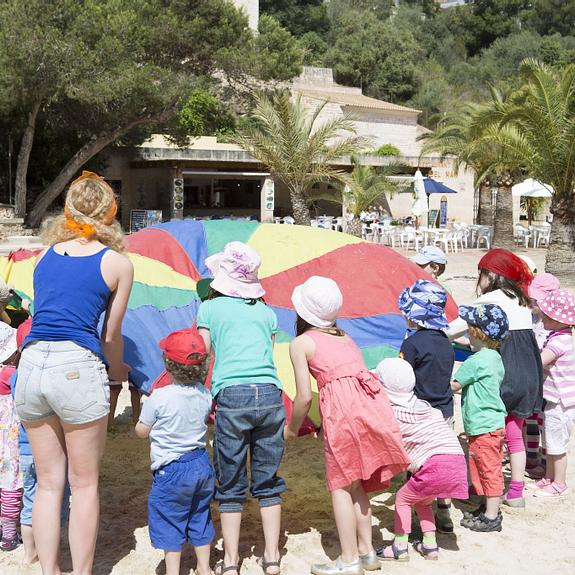Surroundings
VISIT THE MOST BEAUTYFUL PLACES
CALA SANTANYÍ,is one of the calas where you can breathe the beauty of nature. It’s a wonderful white sandy beach surrounded by rising cliffs covered in pine trees. A cove which is made for snorkeling and scuba diving. There is a small path leading to Es Pontàs, a rock in the shape of a natural bridge - a spectacular sight from the sailboat as well as from the coast. Also, spectacular views from sa Torre Nova. During the summer months, Cala Santanyí beach has lounge chairs and umbrellas for rent, a shower and toilets. It has a supermarket, souvenir, coffee shop and restaurants on the beachfront. There is lifeguard on duty here. Lifeguard. Certified beach with the Blue Flag, the most coveted award for beaches.
WHERE TO EAT AND DRINK?
Bistro-Bar Bonavista, Cala Santanyí beach
Restaurante Bonavista Buffet,Hotel Cala Santanyí
Bistro-Bar Bonavista, Cala Santanyí beach
Restaurante Bonavista Buffet,Hotel Cala Santanyí
SANTANYÍ, offers its visitors a great variety of possibilities. It has a fuel station, pharmacy, health center, banks. In addition to offering an excellent gastronomy, you can go shopping and take a walk discovering its rich heritage. On market days, the town's main square becomes a festival where you can buy a wide variety of fresh local products, flowers, clothes, handicrafts of all kinds, all at a good price. The Santanyí market takes place on Wednesdays and Saturdays from 8:00 a.m. to 1:00 p.m. It can be easily reached by car, bus (bus line), by bicycle o walking. Distance from the hotel, 3.77 km.
EVERYTHING YOU IMAGINE!
Texts inspired in texts property from Ajuntament de Santanyí.
SANTANYÍ MARKET, apart from fruit and vegetables, we can also find food stalls (cheese, olives, sausages, preserves, pies, crepes, condiments, etc.), drinks (wines and spirits), clothing, shoes and accessories, flowers and plants, kitchen utensils, decoration and handicrafts (soap, glass, baskets, Santanyí stone sculptures, handmade accessories, etc.)
CONSISTORIAL HOUSE, this building is the Town Hall and was built between 1897 and 1902. The coat of arms on the facade dates from 1705. The clock was built by Miquel Girbend and the bell in the tower was installed in 1904.
PORTA MURADA, this bastion provides access to the walled enclosure of the town. It dates from the 16th century and was crowned with merlons. The small chapel dates from 1878 and is dedicated to the Mare de Déu dels Desamparats (our Lady from the Abandoned). Above the outer portal there is the town´s coat of arms.
S´ALJUB, this construction dates back to 1756. It is a large tank that collects rainwater from the upper part of the town.Formerly it was used to solve the lack of water, especially during the 18th century. It has two portals to extract water manually. It is a rectangular building with a half barrel-vaulted roof. The twin flights of steps staircase were used to access to the terrace.
SES CASES NOVES, this stately house has been the Culture center of the town. It currently has exhibition and conference rooms and the Blai Bonet Contemporary Poetry Center, as well as a permanent exhibition by the German sculptor, Rolf Schaffner. Open every day from 9:00 a.m. to 1:00 p.m. Sundays closed.
S´ABEURADOR,it was built in 1820. This watering place consist on a building with basins or throughs under and outdoor porch with columns, and another circular Wessel in the center of a small square that was used for animals to drink.
SA RECTORIA, the Rectory was built in the second half of the 16th century and it was Always the living quarters of the rectors in the town.
PARISH CHURCH SAN ANDRÉS, it is in a neo-classical style built of Santanyí stone. The first stone of this church was laid on 25th July 1786, a date that has ever since been commemorated by Santanyí´s main festivities, of Sant Jaume. Inside, since 1837, there has been a magnificent Baroque organ built by Jordi Bosch, which permits concerts to be held throughout the year.
PARISH MUSEUM, built at the beginning of the 14th century. Its interior has a ribbed vault inside presents shields on the intersections. To the front there is the main doorway as well as a bell gable housing three bells. Open on market days. See catalogue.
ORGAN JORDI BOSCH, the baroque organ from Santanyí is considered one of the ten best organs in Europe. It was construct at the end of the 18th century. Its sound can be heard from May to October, on market days, at 12:00 a.m. Free entrance. Donations are accepted for its maintenance and restoration.
SANTUARI DE CONSOLACIÓ,architecturally, what stands out most is its fortified appearance, likely due to the Berber incursions suffered in this area in the past. Nowadays, it is listed a Cultural Heritage Site. In its chapel, with a half-barrel vault, we find an altarpiece devoted to saint Scholastica, patron saint of rain, a rare resource in this land. The altarpiece, dates back to 1646, it’s in baroque style is evident in the abundance of flowers and angels depicted, as well as the large shell-shaped dome crowning it.
____________
Texts inspired in texts by www.abc-mallorca.com
Texts inspired in texts by www.abc-mallorca.com
CALA FIGUERA, this picturesque scenic harbor is the main reason for visiting Cala Figuera. The striking coastline forms a Y-shape with two long inlets shaping the well-protected coves of Caló d'en Boira and Caló d'en Busques. The watchtower at the entry of the cove is called Torre d'en Beu and was built in 1569 to defend against pirates. The lighthouse beside it was constructed in 1953. It has some restaurants and supermarkets.
CALA LLOMBARDS, this secluded beach is surrounded by steep cliffs and rocky areas, as well as pine trees and bushes. This secluded beach is surrounded by steep cliffs and rocky areas, as well as pine trees and scrubs. The sand is white and soft and the water is ideal for snorkeling. You can rent lounge chairs and umbrellas and there are a couple of outdoor showers and basic toilets. There is a lifeguard on duty here. There is only one beach bar here. Lifeguard.
CALÓ DES MORO & CALA S´ALMONIA,there are ones of Mallorca´s secret beaches, that everyone knows about. The beach is about 40-metres long and the sea stretches far out between steep cliffs. The beach is surrounded by pine trees and low-lying scrubs and plants. It is one of the more challenging beaches to access. In peak summer months it can be difficult to stake out a place on the sand. There are no facilities, no restaurants, no lounge chairs and umbrellas, no showers and no toilets. There is no lifeguard on duty here.
Access by car is not possible. The best is, you drive to Cala Llombards and park your car in the parking spot, just on the left side of the street at the entrance of this town. A shuttle bus will take you to Cala s'Almonia and Es Caló des Moro. You can reach both of them by bike or on foot.
CALA MONDRAGÓ & S´AMARADOR,both coves are located between two rocky outcroppings, with white sands and clear and calm waters. It is backed up by pine trees and desert plants, which offer lovely paths to wander among or find a bit of shade if needed.
Also, just 400 meters away is its larger sister beach, S'Amarador. It is also surrounded by the Mondragó Natural Park. Both beaches have a small number of sun loungers and umbrellas for rent. It is an excellent place for snorkeling. Facilities are minimal at both beaches with no showers and only a couple of portable toilets on site. S'Amarador has a beach bar and Cala Mondragó offers two restaurants on the beachfront. There is lifeguard on duty here. Lifeguard.
PORTOPETRO, Along the waterfront, cafés and restaurants overlook a delightful marina of fishing vessels and Portopetro's Real Club Náutico. The avenue, Avenida de la Torre, leads to an old watch tower, and a lighthousewhich makes for a stunning viewing point.
CALA D´OR, its architectural style was inspiredby Ibiza and planned so from the beginning. Cala d´Or offers a good combination of bars, restaurants and shops for shopping, including some prestigious firms, and also has a varied nightlife. The 18th-century historicfort ‘Es Fortí’– a protected cultural heritage site of the Balearic Islands – with its cannons and loopholes, is also an exciting place to visit. On the way there you can also enjoy some of Mallorca’s more rugged coastal landscape.
SANTUARI SANT SALVADOR, The Sanctuary of the Mare de Déu de Sant Salvador is a monastery from the mid-fourteenth century. It was built around the time of the Black Death, when it was believed that the altitude would keep the disease at bay. It is located in the municipality of Felanitx, at the top of Puig de Sant Salvador, 509 meters above sea level. The views are spectacular.
The monument to Christ the King was inaugurated in 1934. The 7-meter copper statue stands on a 37-meter platform. The 14-meter Picot Cross is another impressive viewpoint that's a 15-minute walk away. The southeast coast, the castle of Santuery and, on a good day, the island of Cabrera, are visible from here.
Experienced cyclists frequently take on the challenge to the top. If arriving by car, take the PM-4010 road, then the PMV-4011. The church is open daily between 7.00 and 20.00. Mass is celebrated on Sundays at 18.00.






